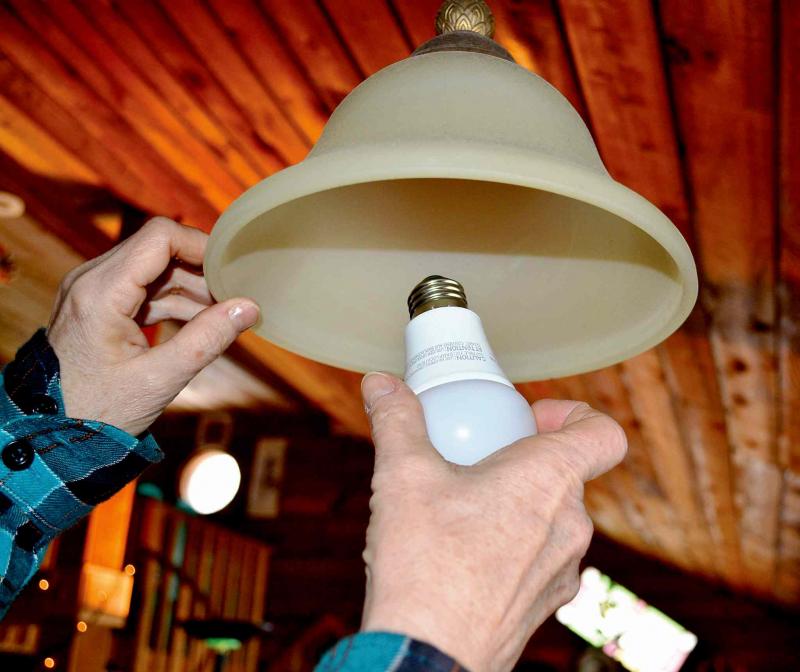Renovation time is a good time to save moolah. It's easy. Just ensure any new light fixtures you buy are equipped with Energy Star approved bulbs and, at the same time, replace existing incandescent lamps in your home with energy-efficient ones. Potential power savings can be almost $140 per bulb.
To lighten up this dry subject -- that includes words such as lumens and watts -- I was going to tell the old gag about how many men it takes to screw in a light bulb. However, in this multicultural, enlightened age, such jokes are considered politically incorrect, especially if you are running for office. But I'm happy to report some feminist friends of mine still delight in telling their version of the aged joke: How many feminists does it take to screw in a light bulb? Two: one to call Gloria Steinem for instructions and another to convey Steinem's instructions to her husband.
Light bulbs have come a long way since Benjamin Franklin lit up the Massachusetts sky by flying a kite in a lightning storm. Thomas Edison later deduced that a thin tungsten filament welded between two electrodes enclosed in an airless or gas-filled globe, provided brighter light for a longer period than a human body. His insight led to the War of Currants, which pitted the virtues of black currants grown under direct current (DC) lights against those grown under alternating current light (AC) lights. The war between Thomas Edison on the DC side and George Westinghouse and Nikola Tesla on the AC side was never truly resolved, though the opening battle favoured AC current. Today, however, we inhabit an almost equal AC/DC world thanks to the invention of transistors and new sources of light.
All of us are familiar with the relatively long-lasting, incandescent light bulb originally mass manufactured by Edison Electric. These inexpensive illuminants are basically electric heaters that generate 90 per cent heat and produce 10 per cent light. Depending on the quality, usually determined by the cost of the bulb, incandescent lights can last from a few hundred hours to about a thousand hours. Moreover, even though the wattage printed on bulbs may be similar, brightness can vary due to the size and quality of the filament and other factors. Generally speaking, as with life expectancy, more-expensive incandescent bulbs will be brighter than cheaper ones, however, the heat to light ratio of household bulbs places them all in the inefficient category.
Halogen-quartz lamps are an improvement on normal household bulbs in that they produce ultra-bright light and last longer because halogen gasses redeposit tungsten on filaments when the power is on. The downside is they operate at an extremely high temperature, making them inefficient and a possible fire hazard as well.
For several years, Manitoba Hydro has been encouraging homeowners to replace incandescent lights and their hybrids with compact fluorescent lights (CFLs) or light emitting diodes (LEDs). The reason for the change is, of course, the number of kilowatts of electricity being gobbled up by incandescent lamps. Last fall, Hydro sold Energy Star approved CFLs and LEDs at half their retail price through big-box stores. LED A19 (traditional style) lamps were priced at about $12 compared with $20 or more at normal retail cost. Whether Hydro will repeat the sale again this fall remains a secret. Keep your eyes open and LED the light shine in.
Hector and Rosanna Martinez, husband-and-wife consultants for hydroelectric producers in Manitoba and Ontario, said dimmable CFLs are now available in numerous designs, including the common household A-lamp. (The pigtail or spring style was never a big hit with consumers.)
2Rosanna said the knock on CFLs is they contain trace amounts of mercury and fluorescent powder that must be properly recycled to prevent them from contaminating the environment.
"When a bulb breaks at home, the debris should be carefully bagged and deposited at a recycling depot," she said, adding burnt-out bulbs should never be disposed of in a landfill unless the site has an appropriate recycling area.
The cost of an A19 CFL 60-watt equivalent lamp is from $7 to $11, depending on the manufacturer and whether the bulbs are purchased as singles or by the case. Home Depot in Winnipeg and Home Hardware in Manitoba have large selections of CFLs.
Though a good-quality LED lamp did cost between $30 and $40, recent mass manufacturing has lowered the cost by about 50 per cent and the technology has been improved so that new bulbs are omnidirectional and dimmable; lifespan can be as high as 25,000 hours with normal use, or nearly 23 years.
Hector said in the near future designations such as 60- or 100-watts, which are generally considered by the public to be the brightness of a bulb, will be replaced by lumens, a measure of the total amount of light emitted by a lamp or other source.
"Lumens are a measure of brightness, while watts are the amount of energy consumed by a bulb. Therefore, the number of lumens emitted by bulbs rated at 60-watts may vary from product to product.
"For example, a 9.5-watt LED bulb that replaces a 60-watt incandescent one produces 800 lumens of brightness, regardless of the wattage. This information guarantees consumers when they purchase a bulb, they will have an accurate measurement of its brightness," said Hector.
LED bulbs produce a warm, flattering light, but emit very little energy-wasting heat and are much more durable than other bulbs as they do not contain a breakable filament and have a shatter-proof globe.
Perhaps the best reason to replace old-style incandescent lights with LEDs is diodes are the most efficient source of illumination available. A single 9.5-watt A19 Energy Star approved bulb can save $138.88 dollars over its lifespan, or 84 per cent in energy costs, according to Luminus Devices Inc.
If still alive, Thomas Edison would be illumined to know DC power may soon outstrip AC power in usage in North America. It seems electrical products containing transistors including computers, printers, radios, televisions and many types of LED bulbs, will only operate on direct current. That's a flip of the switch to the Wizard of Menlo Park.
davidsquare81@yahoo.com




